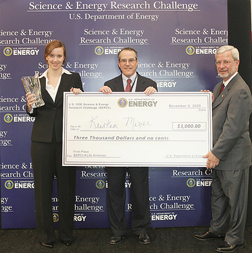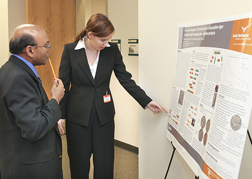Young Scientist Advances Green Research on Biofuel and Plastic Production
Kristen Meyer, a junior chemistry major at Washington State University and former DOE Science Undergraduate Laboratory Intern (SULI), won one of the five awards for the 2009 Science and Energy Research Challenge (SERCh) poster competition for her work with the Pacific Northwest National Laboratory (PNNL) Fungal Biotechnology group.
The annual SERCh poster competition, sponsored by the Office of Workforce Development for Teachers and Scientists within the DOE Office of Science (SC), showcases the research projects of DOE-funded undergraduate students and interns at the national laboratories. This year’s competition was held at Oak Ridge National Laboratory in November, with some 100 student contestants participating.
One may not associate the innocuous mold with a solution to biofuels and green plastics, but mold is more than the annoying substance growing on your cream cheese and ruining breakfast.
The story began when the DOE Joint Genome Institute (JGI) sequenced the genome of Aspergillus niger, a common soil mold that overproduces citric acid, a natural preservative that gives food a sour flavor. JGI, headquartered at Lawrence Berkeley National Laboratory and supported by SC’s Office of Biological and Environmental Research, is the nation’s largest genomic sequencing center specializing in nonmedical microorganisms and plants with relevance to DOE missions in energy, climate, and environment.
“This genome sequence is like having a book that describes the organism” said Kenneth Bruno, a scientist with the Fungal Biotechnology group and Meyer’s mentor in the lab.
 Photo Credit - U.S. Department of Energy
Photo Credit - U.S. Department of Energy
Kristen Meyer, SEARCh winner in the life science category, Jim Roberto, Director of Strategic Capabilities at ORNL, and Gerald Boyd, Manager DOE-ORO.
Picking through an entire genome to associate genes with functions can be daunting. “I first learned about a new technique to more efficiently delete genes of interest while attending the Fungal Genetics conference” said Bruno. “I knew the right student could take this project far.”
Meyer joined the PNNL group as a laboratory technician in 2009 and used this technique to develop a genetic tool to more efficiently identify the genes responsible for the mold’s overproduction of citric acid. “By understanding the genes responsible for citric acid production, we can relate this knowledge to increase production efficiency of important compounds in other Aspergillus strains,” Meyer explains.
Many fungi produce beneficial acids and enzymes that can be used to make plastics or break down plant matter. Overproduction of these items could greatly advance the production of green plastics and biofuels.
The researchers hope to transfer their knowledge to another strain of Aspergillus. “A. terreus makes itaconic acid, which has the potential to replace some of the petroleum used in plastic production” said Bruno.
Concerning Meyer’s input to the project Bruno said “It is one thing to have a project with a nice story, but it is another to have a student come in and make the project her own and do such a great job.”
And her work paid off. Accompanied by her WSU Advisor Kate McAteer, Meyer traveled to Oak Ridge National Laboratory in November to present her research during a poster session alongside 100 other undergraduate DOE-funded interns.
Meyer won the top prize in the life sciences category for her poster entitled Transient Disruption of KusA Gene in A. niger Facilitates High-Throughput Gene Deletion Analysis. For her work, she received a $3,000 scholarship.
 Photo Credit - U.S. Department of Energy
Photo Credit - U.S. Department of Energy
Meyer explains her poster to a judge.
“I believe Kristen and all of the students were nervous during the awards ceremony” said McAteer. “I was confident in her. She did great work.” “It was fun to meet a lot of students who are motivated and doing high level research and all of the cool faculty advisors who accompanied their students,” said Meyer reflecting on the event.
As for the future, “My goal is to work in the medical field,” Meyer said. “I want to earn an M.D. and a Ph.D., so that I can do both research and clinical work.” Meyer hopes to study abroad in Ecuador next year and participate in a biomedicine health program. Upon reflection she added, “My favorite part of working in the lab is understanding how genetic manipulations work and how it completely affects the morphology of the fungi.”
“The opportunities available to students through the Office of Science education programs are incredible” said McAteer. “I am confident that whatever Kristen plans to do in the future that this award will raise her resume above all others. She will definitely stand out.”
The PNNL research was supported by DOE’s Office of Energy Efficiency and Renewable Energy.
This article was written by Stacy W. Kish

